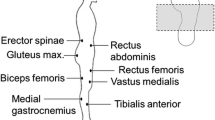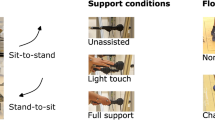Abstract
This paper compares ten regular Yoga practitioners with ten nonpractitioners while performing two single-leg support Yoga postures: Vrksasana (tree posture) and Natarajasana (dancer posture). Thirty-three reflective markers’ trajectories, ground-reaction forces, and EMGs from eleven muscles were registered. Inverse kinematics and dynamics analyses were performed using an OpenSim multibody model. Muscle synergies were extracted from the EMG signals using nonnegative matrix factorization. The required number of synergies to reconstruct the original signal was estimated using a variability-threshold criterion. An additional analysis was performed using the synergy-coordination-index estimation from a minimum global set of eight synergies selected using a similarity index. The Yoga group adopted a more abducted hip at the support leg associated with a higher lumbar bending in the Vrksasana posture. They also used fewer muscle synergies than controls, which correlated positively with the center of pressure rambling trajectory variability, suggesting decreased control complexity. For the Natarajasana, Yoga practitioners showed higher average hip-flexion angle and hip-flexion torque but no differences in synergy parameters. When both groups were combined, the synergy coordination index for Natarajasana was smaller than for Vrksasana, indicating that Natarajasana requires a larger synergy space and is a more challenging task.








Similar content being viewed by others
References
Subramaniam, S., Bhatt, T.: Effect of Yoga practice on reducing cognitive-motor interference for improving dynamic balance control in healthy adults. Complement. Ther. Med. 30, 30–35 (2017)
Ülger, Ö., Yağlı, N.V.: Effects of Yoga on balance and gait properties in women with musculoskeletal problems: a pilot study. Complement. Ther. Clin. Pract. 17(1), 13–15 (2011)
Kelley, K.K., Aaron, D., Hynds, K., Machado, E., Wolff, M.: The effects of a therapeutic Yoga program on postural control, mobility, and gait speed in community-dwelling older adults. J. Altern. Complement. Med. 20(12), 949–954 (2014)
Tiedemann, A., O’Rourke, S., Sesto, R., Sherrington, C.: A 12-week Iyengar Yoga program improved balance and mobility in older community-dwelling people: a pilot randomized controlled trial. J. Gerontol., Ser. A, Biol. Sci. Med. Sci. 68(9), 1068–1075 (2013)
Nick, N., Petramfar, P., Ghodsbin, F., Keshavarzi, S., Jahanbin, I.: The effect of Yoga on balance and fear of falling in older adults. PM&R 8(2), 145–151 (2016)
Mears, S.C., Wilson, M.R., Mannen, E.M., Tackett, S.A., Barnes, C.L.: Position of the Hip in Yoga. J. Arthroplast. 33(7), 2306–2311 (2018)
Mears, S.C., Tackett, S.A., Elkins, M.C., Severin, A.C., Barnes, S.G., Mannen, E.M., Martin, R.D.: Ankle motion in common Yoga poses. The Foot 39, 55–59 (2019)
Salem, G.J., Yu, S.S.Y., Wang, M.Y., Samarawickrame, S., Hashish, R., Azen, S.P., Greendale, G.A.: Physical demand profiles of hatha Yoga postures performed by older adults. Evid.-Based Complement. Altern. Med. 2013, 165763 (2013)
Streeter, C.C., Jensen, J.E., Perlmutter, R.M., Cabral, H.J., Tian, H., Terhune, D.B., et al.: Yoga Asana sessions increase brain GABA levels: a pilot study. J. Altern. Complement. Med. 13(4), 419–426 (2007)
Streeter, C.C., Gerbarg, P.L., Saper, R.B., Ciraulo, D.A., Brown, R.P.: Effects of Yoga on the autonomic nervous system, gamma-aminobutyric-acid, and allostasis in epilepsy, depression, and post-traumatic stress disorder. Med. Hypotheses 78(5), 571–579 (2012)
Brown, R.P., Gerbarg, P.L.: Sudarshan Kriya yogic breathing in the treatment of stress, anxiety, and depression: part I—neurophysiologic model. J. Altern. Complement. Med. 11(1), 189–201 (2005)
Takakusaki, K., Takahashi, M., Obara, K., Chiba, R.: Neural substrates involved in the control of posture. Adv. Robot. 31(1–2), 2–23 (2017)
Balaban, C.D., Porter, J.D.: Neuroanatomic substrates for vestibulo-autonomic interactions. J. Vestib. Res. 8(1), 7–16 (1998)
Pinto, D.P., Moreira, P.S., Menegaldo, L.L.: Postural control adaptations in Yoga single-leg support postures: comparison between practitioners and non-practitioners. Mot. Control 26(3), 412–429 (2022)
Halilaj, E., Rajagopal, A., Fiterau, M., Hicks, J.L., Hastie, T.J., Delp, S.L.: Machine learning in human movement biomechanics: best practices, common pitfalls, and new opportunities. J. Biomech. 81, 1–11 (2018)
Ferber, R., Osis, S.T., Hicks, J.L., Delp, S.L.: Gait biomechanics in the era of data science. J. Biomech. 49(16), 3759–3761 (2016)
Phinyomark, A., Campbell, E., Scheme, E.: Surface electromyography (EMG) signal processing, classification, and practical considerations. In: Biomedical Signal Processing, pp. 3–29. Springer, Singapore (2020)
Ting, L.H.: Dimensional reduction in sensorimotor systems: a framework for understanding muscle coordination of posture. Prog. Brain Res. 165, 299–321 (2007)
Ting, L.H., Chvatal, S.A.: Decomposing muscle activity in motor tasks. In: Motor Control: Theories, Experiments, and Applications, pp. 102–138 (2010)
Lee, D.D., Seung, H.S.: Learning the parts of objects by non-negative matrix factorization. Nature 401(6755), 788–791 (1999)
Barroso, F.O., Torricelli, D., Molina-Rueda, F., Alguacil-Diego, I.M., Cano-de-la-Cuerda, R., Santos, C., et al.: Combining muscle synergies and biomechanical analysis to assess gait in stroke patients. J. Biomech. 63, 98–103 (2017)
Cheung, V.C., Piron, L., Agostini, M., Silvoni, S., Turolla, A., Bizzi, E.: Stability of muscle synergies for voluntary actions after cortical stroke in humans. Proc. Natl. Acad. Sci. 106(46), 19563–19568 (2009)
Banks, C.L., Pai, M.M., McGuirk, T.E., Fregly, B.J., Patten, C.: Methodological choices in muscle synergy analysis impact differentiation of physiological characteristics following stroke. Front. Comput. Neurosci. 11, 78 (2017)
Torres-Oviedo, G., Ting, L.H.: Muscle synergies characterizing human postural responses. J. Neurophysiol. 98(4), 2144–2156 (2007)
Ivanenko, Y.P., Cappellini, G., Dominici, N., Poppele, R.E., Lacquaniti, F.: Coordination of locomotion with voluntary movements in humans. J. Neurosci. 25(31), 7238–7253 (2005)
d’Avella, A., Portone, A., Fernandez, L., Lacquaniti, F.: Control of fast-reaching movements by muscle synergy combinations. J. Neurosci. 26(30), 7791–7810 (2006)
Gizzi, L., Nielsen, J.F., Felici, F., Ivanenko, Y.P., Farina, D.: Impulses of activation but not motor modules are preserved in the locomotion of subacute stroke patients. J. Neurophysiol. 106(1), 202–210 (2011)
Alnajjar, F., Wojtara, T., Shimoda, S.: Muscle synergy space: learning model to create an optimal muscle synergy. Front. Comput. Neurosci. 7, 136 (2013)
Wang, M.Y., Yu, S.S., Hashish, R., Samarawickrame, S.D., Kazadi, L., Greendale, G.A., Salem, G.: The biomechanical demands of standing Yoga poses in seniors: the Yoga empowers seniors study (YESS). BMC Complement. Altern. Med. 13(1), 1–11 (2013)
Wang, M.Y., Greendale, G.A., Yu, S.S.Y., Salem, G.J.: Physical-performance outcomes and biomechanical correlates from the 32-week Yoga empowers seniors study. Evid.-Based Complement. Altern. Med. 2016, 6921689 (2016)
Yu, S.S.Y., Wang, M.Y., Samarawickrame, S., Hashish, R., Kazadi, L., Greendale, G.A., Salem, G.J.: The physical demands of the tree (vriksasana) and one-leg balance (utthita hasta padangusthasana) poses performed by seniors: a biomechanical examination. Evid.-Based Complement. Altern. Med. 2012, 971896 (2012)
Delp, S.L., et al.: OpenSim: open-source software to create and analyze dynamic simulations of movement. IEEE Trans. Biomed. Eng. 54(11), 1940–1950 (2007)
Rajagopal, A., Dembia, C.L., DeMers, M.S., Delp, D.D., Hicks, J.L., Delp, S.L.: Full-body musculoskeletal model for muscle-driven simulation of human gait. IEEE Trans. Biomed. Eng. 63(10), 2068–2079 (2016)
Lai, A.K.M., Arnold, A.S., Wakeling, J.M.: Why are antagonist muscles co-activated in my simulation? A musculoskeletal model for analysing human locomotor task. Ann. Biomed. Eng. 45(12), 2762–2774 (2017)
Lu, T.W., O’Connor, J.J.: Bone position estimation from skin marker coordinates using global optimisation with joint constraints. J. Biomech. 32(2), 129–134 (1999)
Escamilla, R.F., Babb, E., DeWitt, R., Jew, P., Kelleher, P., Burnham, T., et al.: Electromyographic analysis of traditional and nontraditional abdominal exercises: implications for rehabilitation and training. Phys. Ther. 86(5), 656–671 (2006)
Chvatal, S.A., Ting, L.H.: Common muscle synergies for balance and walking. Front. Comput. Neurosci. 7, 48 (2013)
Torres-Oviedo, G., Ting, L.H.: Subject-specific muscle synergies in human balance control are consistent across different biomechanical contexts. J. Neurophysiol. 103(6), 3084–3098 (2010)
Seung, D., Lee, L.: Algorithms for non-negative matrix factorization. Adv. Neural Inf. Process. Syst. 13, 556–562 (2001)
Torres-Oviedo, G., Macpherson, J.M., Ting, L.H.: Muscle synergy organization is robust across a variety of postural perturbations. J. Neurophysiol. 96(3), 1530–1546 (2006)
Routson, R.L., Kautz, S.A., Neptune, R.R.: Modular organization across changing task demands in healthy and poststroke gait. Physiol. Rep. 2(6), e12055 (2014)
Steele, K.M., Rozumalski, A., Schwartz, M.H.: Muscle synergies and complexity of neuromuscular control during gait in cerebral palsy. Dev. Med. Child Neurol. 57(12), 1176–1182 (2015)
Lakens, D.: Calculating and reporting effect sizes to facilitate cumulative science: a practical primer for t-tests and ANOVAs. Front. Psychol. 4, 863 (2013)
Riley, M.A., Wong, S., Mitra, S., Turvey, M.T.: Common effects of touch and vision on postural parameters. Exp. Brain Res. 117(1), 165–170 (1997)
Gatantino, M.L., Bzdewka, T.M., Eissler-Rnsso, J.L., Holbrook, M.L., Mogck, E.P., Geigle, P., Farrar, J.T.: The impact of modified Hatha Yoga on chronic low back pain: a pilot study. Altern. Ther. Health Med. 10(2), 56–59 (2004)
Williams, K.A., Petronis, J., Smith, D., Goodrich, D., Wu, J., Ravi, N., et al.: Effect of Iyengar Yoga therapy for chronic low back pain. Pain 115(1–2), 107–117 (2005)
Santuz, A., Ekizos, A., Kunimasa, Y., Kijima, K., Ishikawa, M., Arampatzis, A.: Lower complexity of motor primitives ensures robust control of high-speed human locomotion. Heliyon 6(10), e05377 (2020)
Konrad, P., Schmitz, K., Denner, A.: Neuromuscular evaluation of trunk-training exercises. J. Athl. Train. 36(2), 109 (2001)
Ting, L.H., McKay, J.L.: Neuromechanics of muscle synergies for posture and movement. Curr. Opin. Neurobiol. 17(6), 622–628 (2007)
Bizzi, E., Cheung, V.C.: The neural origin of muscle synergies. Front. Comput. Neurosci. 7, 51 (2013)
Sullivan, G.M., Feinn, R.: Using effect size—or why the P value is not enough. J. Grad. Med. Educ. 4(3), 279–282 (2012)
Acknowledgements
This study was financed by the Coordenação de Aperfeiçoamento de Pessoal de Nível Superior – Brasil (CAPES) – Finance Code 001, by CNPq, FAPERJ, and FINEP.
Author information
Authors and Affiliations
Corresponding author
Ethics declarations
Competing Interests
The authors declare no competing interests.
Additional information
Publisher’s Note
Springer Nature remains neutral with regard to jurisdictional claims in published maps and institutional affiliations.
Supplementary Information
Below is the link to the electronic supplementary material.
Rights and permissions
Springer Nature or its licensor (e.g. a society or other partner) holds exclusive rights to this article under a publishing agreement with the author(s) or other rightsholder(s); author self-archiving of the accepted manuscript version of this article is solely governed by the terms of such publishing agreement and applicable law.
About this article
Cite this article
Menegaldo, L.L., Pinto, D.P., Clemente de Oliveira, H.L. et al. Kinematics, dynamics, and muscle-synergy analysis of single-leg Yoga postures. Multibody Syst Dyn 58, 137–155 (2023). https://doi.org/10.1007/s11044-023-09887-8
Received:
Accepted:
Published:
Issue Date:
DOI: https://doi.org/10.1007/s11044-023-09887-8




